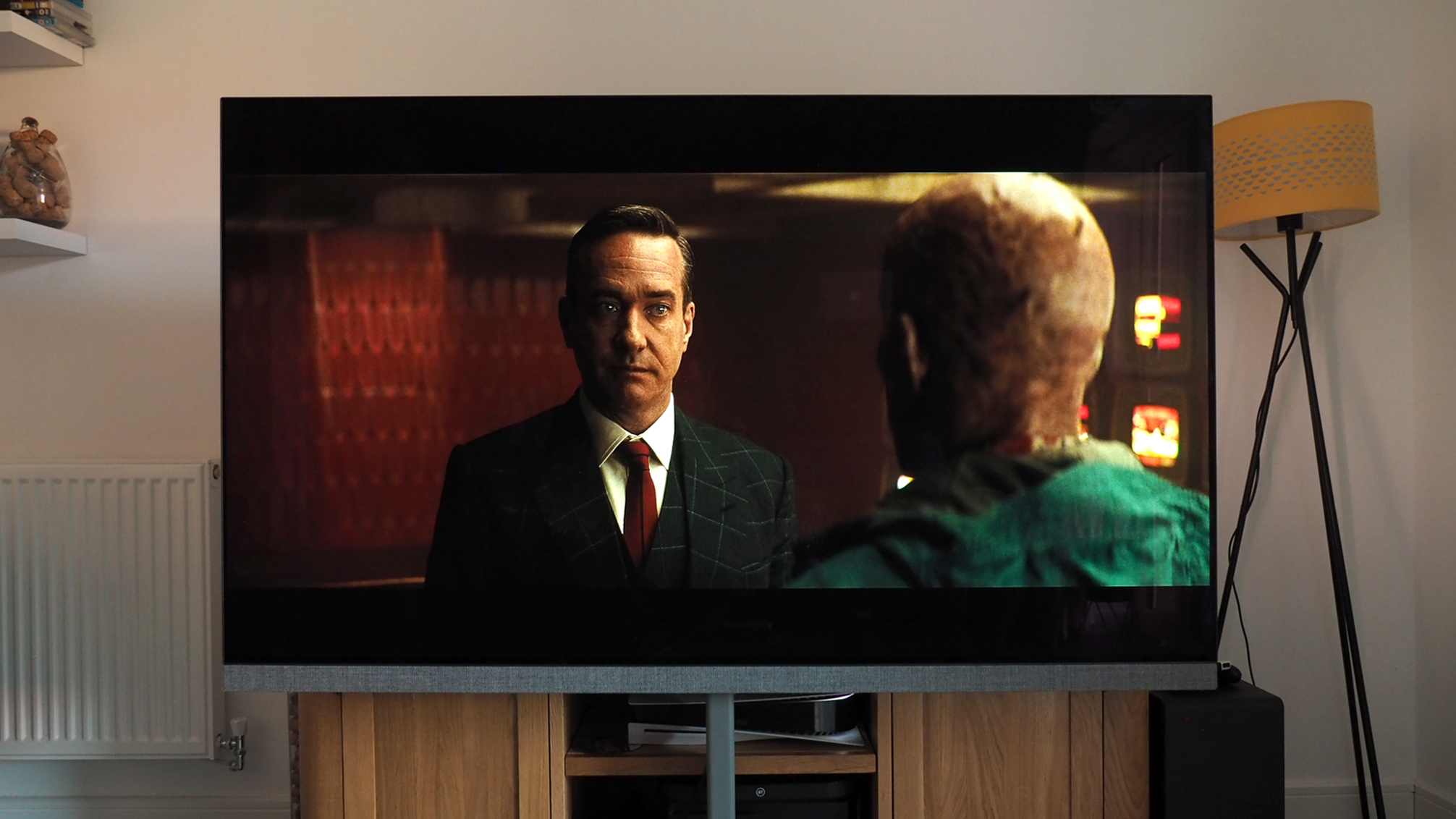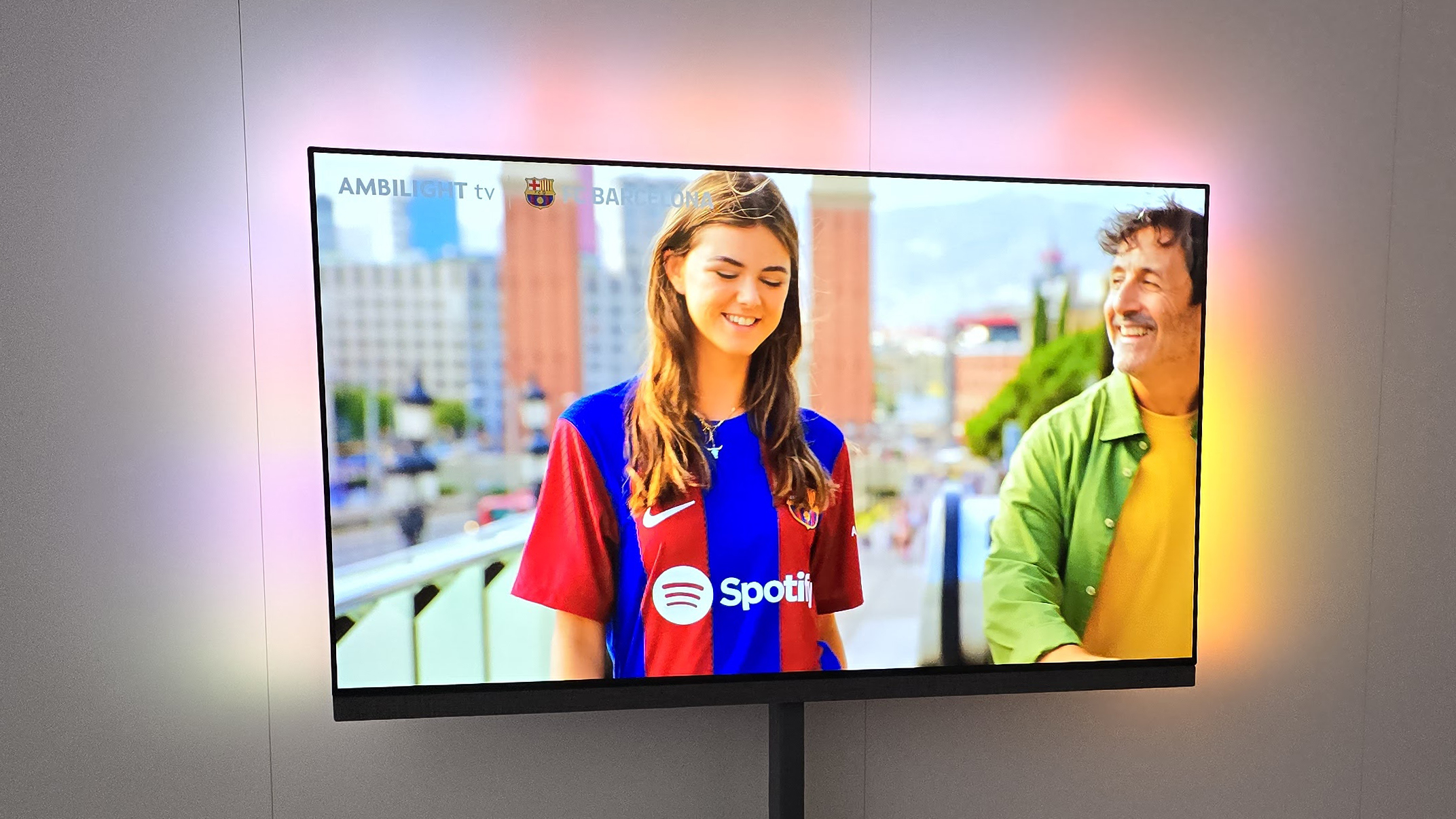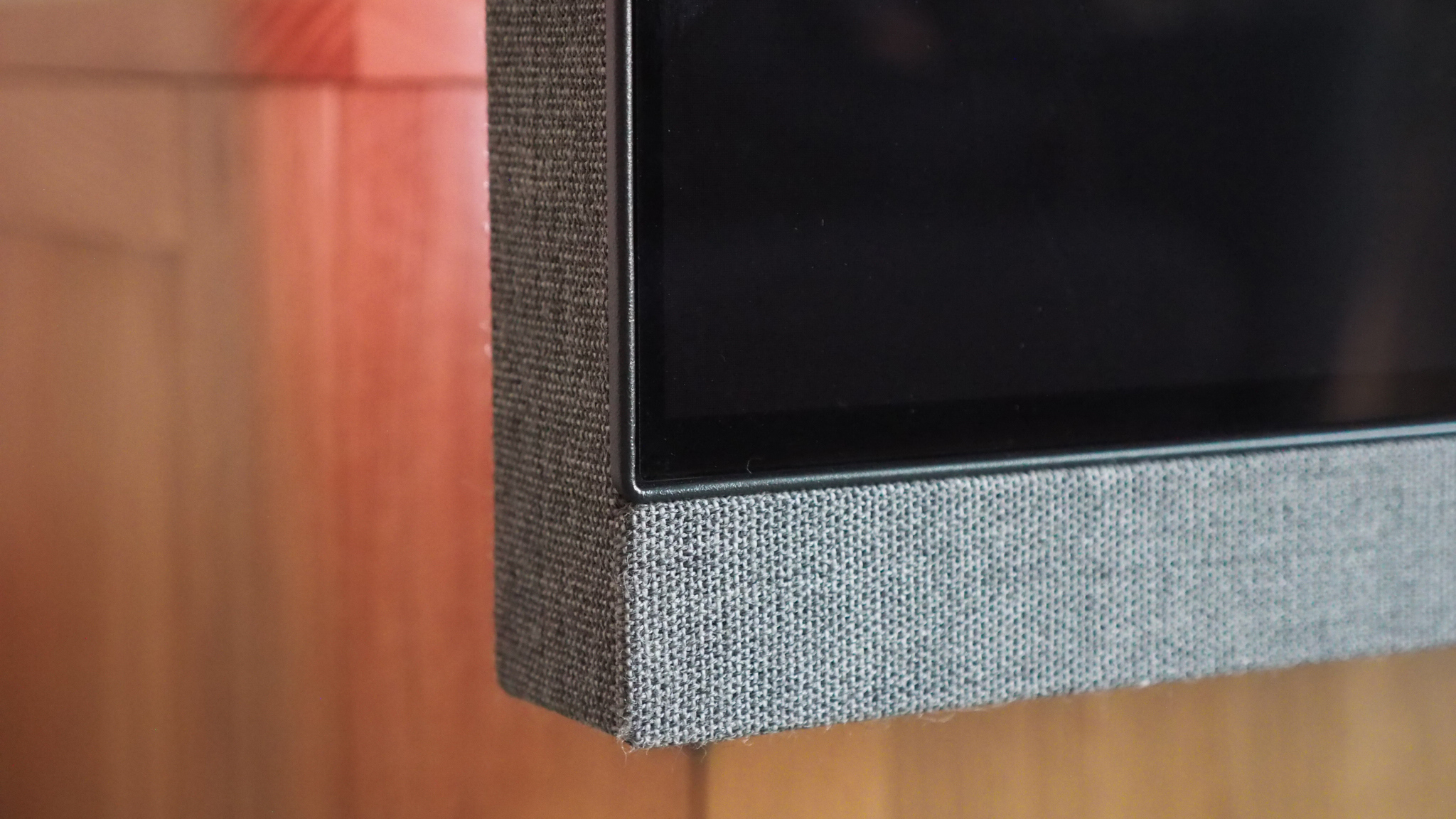
Philips has had a storming year, with the OLED 809 and OLED 909 models delivering competitively priced alternatives to the LG, Samsung and Panasonic sets also found among the best OLED TVs of the year. Both those Philips models are 5-star tellies.
But the brand isn't done there: 2024 is also when the company's top-tier, free-standing telly got a refresh – and in fine style. The Philips OLED 959, on review here, has been in my possession for a number of weeks to get the inside line on whether this niche-yet-impressive set is the best of all worlds.
The OLED 959 is the very first Philips set to introduce Ambilight Plus – the next-generation in the company's real-time lighting projection system, which makes images appear as if they're bleeding beyond the screen – plus upgraded Bowers & Wilkins integrated sound system, and uprated picture processing engine.
However, with the company's OLED 909 a largely similar viewing experience – albeit with four-sided Ambilight (the now 'previous-gen' version) – the free-standing nature of the OLED 959 will simply rule it out of the practicality books for most people. And, as I'll get to, that new Ambilight system isn't going to be to everyone's tastes either...
Philips OLED 959 review: Price & Availability
The Philips OLED 959 comes in one size and one size only: 65-inch. That makes sense, as its free-standing nature – the significant stand is included in the box, of course – demands it be the centrepiece of attention.
It's priced at £3999 in the UK, not available in the USA, and the Australian website doesn't have any mention of the set. As such this is a model aimed at the European market only – and, in the UK, available from Richer Sounds exclusively.
For context: that asking price means the OLED 959 is an additional £1,300 more than its OLED 909 cousin. And for that kind of money, you could add on one of the best soundbars or surround systems and still leave with some change.
Philips OLED 959 review: Features & What's New?

In the upper echelons of Philips' TV line-up, the company has put out large-scale free-standing monolith sets before, most recently the OLED 986 – which is effectively the predecessor to the 959 model on review.
There's also the OLED 937, which doesn't have the same mega-stand design element, but which does have an integrated sound system (except in soundbar-alike style) – and which could be loosely considered as the 'lite' precursor to the 959 TV on review here.
That's all just for context, though, as the Philips OLED 959 is an upgrade to those older sets in many ways. Its Meta 2.0 OLED panel – that being 'MLA' (Micro Lens Array, complete with heat sink) – is the super-bright type that you'll also see in the Panasonic Z95A and some competitors. Philips has the uprated 8th Gen P5 Dual Engine AI Processor here, though, which has even more processing potential compared to the OLED 909.

Ultimately, though, the panel in the OLED 909 and OLED 959 are the same – I know other reviewers who have seen a marginal brightness bonus from one set or other (depending on the measurement window), but not to the point where you'll see it by eye, realistically.
Therefore the OLED 959's key benefits are the free-standing design, the new Ambilight format – noting the downgrade from four-sided to three-sided – and the differences with the integrated Bowers & Wilkins sound system.
Feature-wise, the general overview is otherwise an echo of the OLED 909: two of the four HDMI ports are the 2.1 standard, with port number two being the HDMI eARC slot – not that with this kind of integrated sound system you're likely to ever want an additional soundbar via eARC – and support for 4K at 144Hz (a step up over the usual 120Hz maximum, which PC gamers may appreciate).
Philips OLED 959 review: Design & Setup




While the design section of our reviews tends to be further down the page, it's just such an important factor with the OLED 959 that it had to be moved up. Because, as you can see from my pictures, this TV wants to be the focal point, the star of the stage, the standout feature in your room.
On that one hand that's great: herein lies a standalone TV, with a hidden cables pipeline down the rear of the stand itself, which could make minimalist homes look even more feng shui. On the other hand hardly anyone (that I know, at least) is going to be able to accommodate such a look: plus you've got to house your AV gear nearby enough anyway, so that's something to consider.
Actually setting up the TV itself is trickier than your average (and, believe me, setting up the best TVs is a big part of my job). That's because you build the stand first, then have to hoist the panel – all almost-30kgs of it – onto the upright stand before screwing it in. It's a confident two-person job, no doubt, as any 65-inch TV ought to be, really.
As you can also see from my pictures, the OLED 959 is no slender panel either – I measure it at around 5.2cm. OLED panel types owe themselves to slimmer practicalities, of course, but this TV's focus on delivering the best sound in addition to the best vision means a lot more width has been allocated to allow that sound system to really ring supreme.

Once it's hung on the stand and screwed in, the bottom edge sits 48cm-ish from the ground. To me that's a good 22cm lower than my usual on an AV cabinet – so the set looks a little low-slung (especially in my setup, as per the photos, with the AV panel sat behind it for the majority of this test – not all the time, mind, moving things for some integral Ambilight experiments). It'll suit some, but not all, therefore.
Whether you like the style of the OLED 959 is another factor. I think the Kvadrat fabric coatings covering the side positions (the material covers all four edges) are synonymous with audio kit – albeit, I know it best from Bang & Olufsen's products rather more than Bowers & Wilkins. Again, it won't be to everyone's tastes – I like it, but each to their own.
Setting up the TV involves using the classy included remote – which on the Wi-Fi password entry screen was super laggy, no idea why, but fortunately cleared up thereafter – to dig into the Google TV settings (deciding if you will or won't permit access for a more personalised experience).





As I've said of other Philips sets, I just don't find Google TV especially well-integrated. Certain button presses on the remote will be met by a "Feature is not available in current mode" message, with Philips' own menus sort-of clashing with Google's own at times. Getting certain picture settings requires one route, while others are only available from a different menu. No TV-maker seems to have the perfect solution – and Panasonic's Fire TV integration went too ad-heavy – but there's still room for improvement here.
However, that Philips remote is a lovely bit of design. It features illuminating Netflix, YouTube, Prime Video buttons (in addition to a further 'apps one). It offers access to many of the best streaming services, just not all the UK ones – although, fingers crossed, that should be coming in the future. I think the illuminating volume and channel up/down buttons as raised toggles is a great touch too.
Philips OLED 959 review: Picture Quality

As I said further up, the Philips OLED 959's panel is effectively the same as that of the OLED 909's – just with some processor differences. In my experience, therefore, with Filmmaker Mode taking movie preference, the viewing experience is basically the same – and glorious indeed.
MLA brings a lot more brightness potential – not that the set will always use it (you'll want to banish 'Eco' mode immediately). So while the 959 is technically brighter than many current step-down panels, you won't necessarily always notice it – and if the toggles for Light Level Optimisation and/or HDR Optimisation are checked then all the more so, depending on your ambient conditions.
But I don't find the OLED 959's visuals all-round better than the OLED 909 (which is my current daily TV, by the way). For me that's down to the processing: while there's more power from the processor, I've spotted more juddery motion-processing artefacts than I'd expected. And not in high-brow content either: watching BBC 1's MasterChef: The Professionals, with all the white-coated chefs moving about on-screen, I could see quite notable motion artefacts around subjects' edges.
In addition my HDMI sources sometimes – and I stress not all the time – presented a single far-right-positioned (not politically) vertical strip of brighter pixels. I presumed this was related to Pixel Shift – as the image can be offset by a single pixel to avoid burn-in – but digging into settings to switch this off didn't resolve it. Neither did adjusting default screen fill, performing a Residual Image Clean (just in case – I couldn't see any burn-in presence), nor doing a full reset of the TV.

There's another issue that's likely going to be contentious too: the Ambilight Plus system. Personally I don't like it as much as the previous version – I find its higher resolution output can, in default settings, render the image extension a little too prominently. The movement is different – quicker by default – and I find it simply more distracting.
However, the Ambilight settings permit many adjustments, so you can more-or-less default it back to the previous-generation style. Maybe I'm too used to that and will be called out for living in the past – but that's just my view, having lived with the set for some weeks.
But there's no avoiding that putting this new Ambilight system onto only three sides – especially on a free-standing TV design such as this – feels like the wrong decision to me. There might be a cost-effectiveness reason there, sure, but there was also the opportunity to really show off this new system around all edges of the screen – something even the OLED 909 offers (with its non-Plus version, admittedly) – and which lacks on the bottom edge.



All of which probably reads like I'm whingeing about this TV. I see it more as fair observation – especially when its 909 cousin has continued to impress me so much. Fortunately the OLED 959 echoes all the good parts of its cousin's image quality boons too – and it often looks absolutely amazing.
The main thing in having this new Philips TV setup that I noticed the most is the perceptible sharpness uplift. Compared to my outgoing TV (I won't name and shame) it gives on-screen characters so much more bite, with an enhanced depth of field that's just stunning to take in. Side-by-side testing has made that hugely evident.
That new dual image processing engine – ignoring the motion comments – seems to have an even more delicate hand when it comes to black-level handling. Even with punchy brightness and dazzling colours, the deeper elements – as observed in Deadpool & Wolverine – are well-handled, while presenting significant contrast for a rich visual. It's a closer-run game against the Panasonic Z95A leader than I'd expected.

I've tested the OLED 959 with all manner of media from multiple sources – including switching HDMI ports to test the same output results – whether digging into the best streaming services or catching a 4K Blu-ray movie. Or even just a good ol' Blu-ray – with the Bruce Willis-starring Jackal from 1997 a recent one I've dug back out, showing off the set's 1080p upscaling to great effect (it's not remastered either, as the hairs-'n'-all on the film show – and I'm not just talking about Brucey's hairline).
Philips is also one of the few offering compatibility with all the main HDR formats – HDR, HDR10+ (and Adaptive), Dolby Vision, and HLG – so there are no limitations to the source material being displayed. The various Optimisation features can over-rule these, do note, so keep an eye out on whether you do or don't want additional processing to smooth motion, increase brightness, raise dark levels and so forth – as it's all on offer here.




Going back to Ambilight for a minute: the Plus version is actually more delicate if the panel isn't too close to a wall. The first two times I saw the set exhibited at various Philips events it was right against the wall to magnifty the effect – but a free-stander such as this might not always be positioned as such.
Oh, and purists will still appreciate the bias viewing availability from a single colour output (wall-matched if you wish) rather than real-time motion. There's still a lot of versatility to Ambilight, which I've always loved, so tweak the settings to your preferences and it's absolutely still a stand-apart feature.
Philips OLED 959 review: Sound Quality





Bowers & Wilkins has a long-time partnership with Philips and has delivered some exceptional results in various TVs over the years. That usually depends on the TVs being larger-scale models, however, but the OLED 959 is perfectly positioned as a 65-incher only – and its results are fantastic.
Compared to its OLED 909 cousin, which has a 3.1 built-in system, the OLED 959 has a 5.1.2 integration. That means left, centre and right to the front, plus left and right rears to make up that '5'; a centre woofer as the '.1' part; and the '.2' represents two proper upfiring speakers – no pseudo required for that height.
Now you're never going to get true immersion from a system that's entirely in front of you, granted. But the soundstage width, precision to on-screen dialogue, and the overall height from this set is great. Sound quality is rich and it can decode the relevant sources, such as Dolby Atmos, to ping sounds at angles most normal TVs can only dream about.
You'll never need a soundbar with the OLED 959, therefore, but an additional subwoofer wouldn't go amiss. The 7.5in unit at the back here, paired with two radiators, is decent enough – but the same as you'll find in its OLED 909 cousin, so no upgrade. I've listened with a separate subwoofer attached at a Bowers & Wilkins demonstration and the results are slap-around-the-face good.
Philips OLED 959 review: Verdict

The Philips OLED 959 represents the top offering in the company's OLED TV line-up – and it's a stunner in many departments, from the way it looks, to the quality of visuals and audio it can output in all its Ambilight glory.
However, the practicalities with a set such as this simply won't suit all. I find its stand positions the screen marginally too low for my tastes. Not everyone is going to love the Kvadrat cloth-covered edges either. Furthermore, the new Ambilight Plus is only present on three rather than four sides – a missed opportunity in a free-standing design such as this.
Ultimately, the OLED 959 is a niche proposition – one that's fully aware that's the case – that embraces its own being. It stands apart from the crowd for many of the right reasons – with some minor motion, anti-burn-in and Ambilight caveats – and represents a sound and vision powerhouse that only a handful will ever likely possess.
Also consider
Given the Philips OLED 909 plus a soundbar system (a high-end one with surrounds included) could be had for less cash and delivers very similar image quality, that's the obvious alternative to pick from within Philips' own camp.
Otherwise I'd look adjacent and plump for the Panasonic Z95A for its class-leading black-level handling – plus it's also got a good-enough integrated sound system (tuned by Technics, no less) and won't cost you quite as much either.







